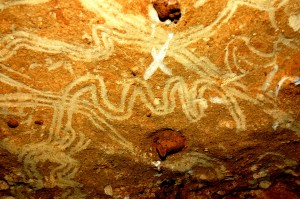 Archaeologists studying the 13,000-year-old cave art in the Cave of a Hundred Mammoths in Rouffignac, France, have discovered that some of the designs were painted by children. One particular area of the cave is replete with finger painted lines in a variety of geometric shapes called finger fluting that were made by children. Researchers have identified the marks of four children between two and seven and four adults working in this chamber.
Archaeologists studying the 13,000-year-old cave art in the Cave of a Hundred Mammoths in Rouffignac, France, have discovered that some of the designs were painted by children. One particular area of the cave is replete with finger painted lines in a variety of geometric shapes called finger fluting that were made by children. Researchers have identified the marks of four children between two and seven and four adults working in this chamber.
“It suggests it was a special place for children. Adults were there, but the vast majority of artwork is by children,” said Jess Cooney, a PhD student at [Cambridge University]’s archaeology department.
“It’s speculation, but I think in this particular chamber children were encouraged to make more art than adults. It could have been a playroom where the children gathered or a room for practice where they were encouraged to make these marks in order that they could grow into artists and make the beautiful paintings and engravings we find throughout the cave, and throughout France and Spain. Or it could have been a room used for a ritual for particular children, perhaps an initiation of sorts.”
Most of the art in the cave is finger fluting. The animal figures it is most famous for are actual a small minority of the paintings. Artists, adult and child alike, would run their fingers over a soft red clay and then draw swirls and triangles on the cave wall. The size of the lines indicates the size of the fingers doing the painting. Designs high on the wall and on the ceiling indicate that the small children were being held up by adults, and the juxtaposition of different hands suggest a small adult, possibly an older brother, painting alongside a seven-year-old girl, and an adult guiding the fingers of a two-year-old.
The most prolific artist throughout the entire cave complex is a five-year-old girl. The range of the paintings done by children indicates that the Stone Age dwellers of Rouffignac placed few restrictions on their children’s movements. The were painting the walls even in the darkest, most distant caves.
Some of the children’s art goes beyond swirls and lines. There are finger fluted animals and what look like outlines of faces, but most notably there are hut shapes called tectiforms which are symbols native to one area of France. Those tectiforms are the first known example of Stone Age children creating symbolic figures.
I am somewhat skeptical of the repetition of the artists’ ages and genders. If that isn’t just speculation, then how did they determine this data?
I was curious about the analysis as well. The Wikipedia page on finger fluting sheds some light on the methodology. As is typical with prehistoric studies interpretations run wild but it’s definitely intriguing. (and fun to imagine a bunch of prehistoric kids doodling on a cave wall on a rainy day.)
I wondered about how they determined those factors, too. This article from Cambridge University clarifies the methodology used to obtain age/gender. http://www.cam.ac.uk/research/features/prehistoric-pre-school/
Judging my gender from the relative length of my fingers would yield the wrong answer, so color me still skeptical.
If there is a full fingerprint indent than it is easy to determine the size, then age. Look at the shape of the fingers to determine the gender: males have larger fingers and women have more slender fingers.
They seem little too excited on determining it was a 5 year old girl…no way you can determine it was a girl or boy. Wishful thinking at best.